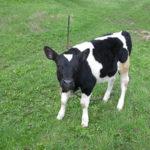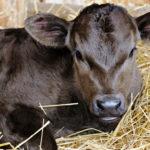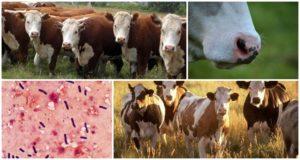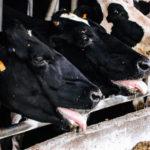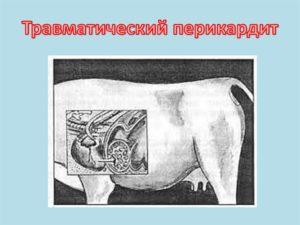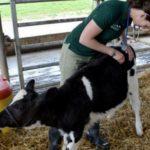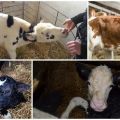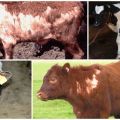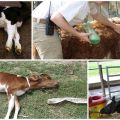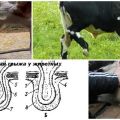Causes and symptoms of bronchopneumonia in calves, treatment regimens and prevention
For successful breeding of cattle and getting a good profit from it, you will need not only proper care, but also the ability to identify diseases and carry out their adequate and timely treatment. One of the most common pathologies in calves is bronchopneumonia. Also, the prevention of this dangerous disease is of no less importance.
What is bronchopneumonia?
Otherwise, this pathology is called catarrhal pneumonia. Since the calves suffer quite often, and the consequences often lead to the death of animals, farm owners suffer considerable material damage. The respiratory system of the body, namely the bronchi and alveoli, mainly suffers from the disease. In some cases, other organs are also affected. In the future, intoxication occurs, and the weakened body of the calf is exposed to even greater negative effects.
Bronchopneumonia in calves is treatable, but it has a number of complications:
- breeding qualities of males are deteriorating;
- reproductive function suffers;
- poorly gaining body weight.
The disease is not contagious, therefore it is not contagious. The provoking factors are colds and hypothermia.
The disease lasts a long time and involves the following changes in the body:
- damage to the central nervous system;
- accumulation of blood in the lungs;
- swelling of the bronchi and bronchioles;
- pneumonia;
- breathing disorder.
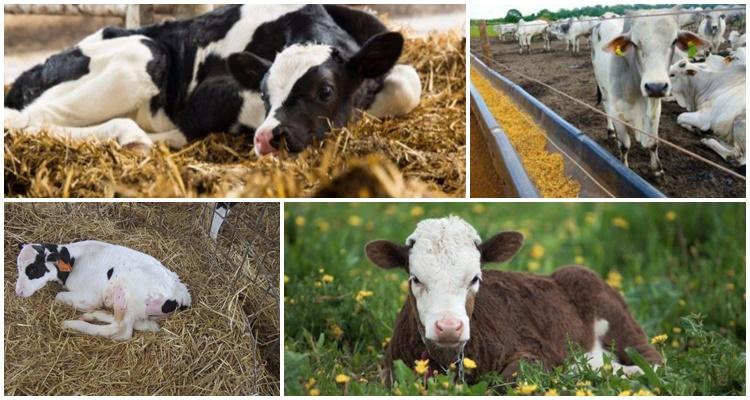
Where the focus of inflammation is localized, the functions of the lungs are impaired, as a result of which healthy areas are forced to take on an additional load. Shortness of breath appears, body temperature rises. Further, the kidneys are affected - the work of the filters is disrupted.
If the liver is weakened, then toxic substances enter it from the gastrointestinal tract, from where they are carried throughout the body with the blood stream, triggering inflammatory processes in organs and tissues.
After the death of a calf due to bronchopneumonia, the following changes are found in its body:
- lumps in the lungs;
- swelling of the upper respiratory tract;
- the heart has an unnatural hue;
- damage to the bronchi and lungs;
- mucus in the bronchi and bronchioles;
- uneven lung surface;
- lesions in the upper lungs;
- the presence of granular formations in the lungs;
- enlarged liver;
- inflammation of the lymphatic system.
Causes and symptoms of the disease
The reasons for the development of bronchopneumonia in calves are different:
- lack of vitamins (A and C);
- poor conditions of detention (lack of normal ventilation, unsystematic cleaning of the room, which makes the air dusty and the room dirty);
- improper metabolism, disturbances in the work of the digestive system;
- stress;
- unsuitable pair for offspring, as a result of which calves are born with physiological abnormalities and weakened immunity;
- hypothermia or overheating (drafts, cold, hot and dry air);
- colds, let go;
- high level of humidity in the room where the animals are;
- mistakes when feeding with colostrum.
Acute form
There are three forms of the course of the disease:
- sharp;
- subacute;
- chronic.

Each of them is characterized by certain symptoms. The acute stage develops within 10 days. During this period, the calf needs urgent veterinary care, a thorough examination, and a sample collection. The signs of acute bronchopneumonia are as follows:
- Weakness.
- Lachrymation.
- Reluctance to eat.
- Discharge of mucus from the nose (gradually turns into pus).
- Throat breathing.
- Cough. First dry and sparse, then (if not properly treated) wet and frequent.
- Breathing through the mouth.
- Elevated white blood cell count (determined by tests).
Subacute
Lasts for 2-4 weeks. The symptoms of this stage are:
- Lack of appetite.
- The calf's weight is reduced (as a consequence of the first point).
- A slight increase in temperature in the evening (normal during the day).
- Dyspnea. The calf begins to wheeze.
- Diarrhea.
- There are exacerbations in the form of a sharp increase in temperature and deterioration in health.
Chronic
This form of the disease in cows is characterized by the following symptoms:
- Persistent cough.
- Runny nose.
- Wheezing in the lungs.
- Lagging in physical development.
Calves with chronic bronchopneumonia are discarded. At the same time, they cannot be sent for slaughter, since the meat of such animals is not recommended for consumption, even after thorough heat treatment.
Diagnostic methods
You can establish the presence of pathology according to the results of laboratory tests:
- blood chemistry;
- X-ray of the lungs (in the presence of bronchopneumonia, local darkening, a clearer bronchial pattern, a blurred cardio-diaphragmatic pattern are found in the picture);
- Analysis of urine;
- bronchopulmonary test.
It is also necessary to assess the conditions of keeping the young, the behavior of the calf (both in grazing and indoors). All this information is essential for making an accurate diagnosis.
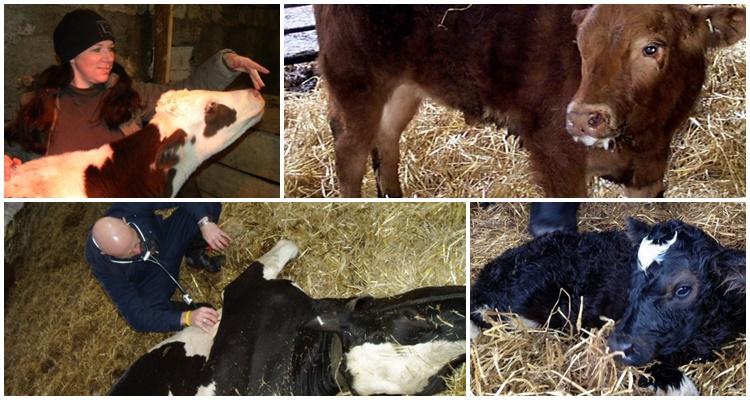
When diagnosing, it is important to distinguish the symptoms of bronchopneumonia from the signs of other (similar) diseases. For example, a cough in calves can occur for the following reasons:
- helminthiasis (echinococcus accumulates in the lungs and provokes a cough);
- the presence of a foreign object in the upper respiratory tract;
- pollen allergy;
- chemical poisoning.
Methods for treating bronchopneumonia in cattle
A sick calf is housed in a separate enclosure and provided with the necessary care. The main measures of therapy include the following procedures:
- Inhalation. Strengthens blood circulation, substances are quickly and easily absorbed. For the procedure, you will need turpentine, baking soda, herbs, oil extracts, proteolytic enzymes.
- Antibiotic course.
- Taking anti-allergenic drugs.
- Increasing the protective functions of the body with the help of immunostimulants.
Antibacterial therapy
The calf treatment regimen is based on the use of antibiotics - "Penicillin" and "Streptomycin". These medicines are effective for acute bronchopneumonia.The first drug is injected intramuscularly, the second - intravenously three times a day. The course of therapy is about a week.
Antiallergic drugs
Antihistamines reduce vascular permeability and improve the absorption of antibiotics, preventing drug allergies. Among the common drugs prescribed for catarrhal pneumonia are:
- Suprastin;
- calcium gluconate;
- sodium thiosulfate;
- "Pipolfen".
Immunostimulants
The disease weakens the protective functions of the body, therefore it is necessary to help it in the fight against the disease. For this, immunostimulants are used, including blood serum taken from healthy animals.

Problem prevention
To prevent the development of bronchopneumonia in the calf, you should resort to the following measures:
- proper nutrition, rich in vitamins;
- maintaining optimal conditions of detention (temperature, humidity, cleaning of premises, ventilation, disinfection, etc.);
- regular walking;
- the flooring must be wooden;
- the presence of a canopy on the walking area (so that the calves can hide under it from the heat and rain);
- regular examination of calves by a veterinarian;
- chest massage;
- proper care of pregnant cows.
Bronchopneumonia is a serious but treatable condition that often occurs in calves. It is important to observe preventive measures, and if signs of pathology appear, immediately call a veterinarian and, if required, begin adequate treatment.
